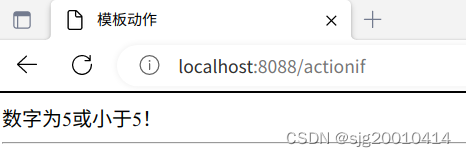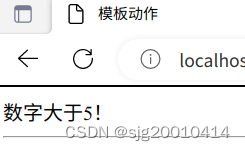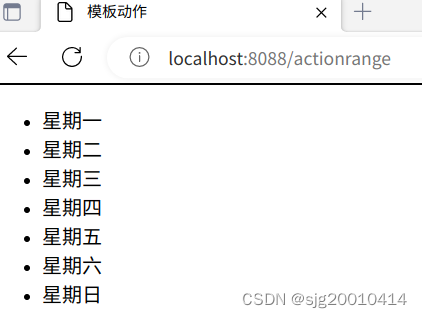您现在的位置是:首页 >学无止境 >golang web学习随便记6-模板引擎网站首页学无止境
golang web学习随便记6-模板引擎
以下代码是几乎最简单的一个模板,{{ . }} 表示执行模板时将嵌入的数据
<!DOCTYPE html>
<html>
<head>
<meta http-equiv="Content-Type" content="text/html; charset=utf-8">
<title>Go Web 编程</title>
</head>
<body>
{{ . }}
</body>
</html>程序也足够简单,就是解析模板文件得到模板对象,执行模板输出结果
package main
import (
"html/template"
"net/http"
)
func process(w http.ResponseWriter, r *http.Request) {
t, _ := template.ParseFiles("tpl.html")
t.Execute(w, "Golang编程就是简单")
}
func main() {
server := http.Server{
Addr: "127.0.0.1:8088",
}
http.HandleFunc("/process", process)
server.ListenAndServe()
}
运行结果为

模板可以是模板文件,也可以是字符串,在上述代码中添加一个处理器函数
// ...........................
func process2(w http.ResponseWriter, r *http.Request) {
strtpl := `
<!DOCTYPE html>
<html>
<head>
<meta http-equiv="Content-Type" content="text/html; charset=utf-8">
<title>Go Web 编程</title>
</head>
<body>
{{ . }}
</body>
</html>
`
t := template.New("strtpl.html")
t, _ = t.Parse(strtpl)
t.Execute(w, "字符串模板也简单")
}
// .......................
http.HandleFunc("/process2", process2)
// .......................
其实,对于文件模板,也是可以先New一个模板实例,然后用实例的ParseFiles方法解析模板文件。直接template.ParseFiles相当于生成了以文件名为模板名的模板实例。ParseFiles方法接受的参数是可变个数的,所以,实际应用中是一堆模板相互嵌套时,会把参数先放在一个数组,然后调用ParseFiles时将数组打散传入。模板中有多个文件时,必须有一个“主模板”,如果执行模板时没有指定“主模板”(调用的是Execute方法),那么第一个将作为“主模板”。指定主模板时(调用的是ExecuteTemplate方法),如果模板是未命名的,那么就用模板文件名作为模板名。模板解析过程中可能产生错误,用 template.Must(...) 包裹模板解析函数的调用过程是一种“偷懒”的错误处理模式,这种模式下,发生错误时将产生panic。
golang web学习随便记1-快速入门_sjg20010414的博客-CSDN博客 中有基本的模板嵌套情况。
下面我们来看模板中的动作。先来看条件动作:模板文件tpl.html
<!DOCTYPE html>
<html>
<head>
<meta http-equiv="Content-Type" content="text/html; charset=utf-8">
<title>模板动作</title>
</head>
<body>
{{ if . }}
数字大于5!
{{ else }}
数字为5或小于5!
{{ end }}
<hr>
</body>
</html>package main
import (
"html/template"
"math/rand"
"net/http"
"time"
)
func actionif(w http.ResponseWriter, r *http.Request) {
t, _ := template.ParseFiles("tpl.html")
rand.Seed(time.Now().Unix())
t.Execute(w, rand.Intn(10) > 5)
}
func main() {
server := http.Server{
Addr: "127.0.0.1:8088",
}
http.HandleFunc("/actionif", actionif)
server.ListenAndServe()
}
运行并从浏览器访问,得到的结果可能是2种之一:


然后来看迭代动作 :需要注意的是,迭代动作range,有可选的(fallback)选项 else,即没有数据时显示点什么。如果没有该选项,要处理无数据提示会麻烦很多。
<body>
<ul>
{{ range . }}
<li>{{ . }}</li>
{{ else }}
<li>当前无数据</li>
{{ end }}
</ul>
</body>
package main
import (
"html/template"
"net/http"
)
func actionrange(w http.ResponseWriter, r *http.Request) {
t, _ := template.ParseFiles("tpl.html")
daysOfWeek := []string{"星期一", "星期二", "星期三", "星期四", "星期五", "星期六", "星期日"}
t.Execute(w, daysOfWeek)
}
func main() {
server := http.Server{
Addr: "127.0.0.1:8088",
}
http.HandleFunc("/actionrange", actionrange)
server.ListenAndServe()
}
显示结果为:

前面代码中,{{ . }} 的值都是golang代码执行模板时提供的确定值,但模板也提供了设置动作,可以在指定区域内使用模板内设定的其他值。
<body>
<div>最难的语言是 {{ . }}</div>
<div>
{{ with "C++" }}
最难的语言是 {{ . }}
{{ else }}
最难的语言还是 {{ . }}
{{ end }}
</div>
<div>最难的语言又是 {{ . }} </div>
</body>package main
import (
"html/template"
"net/http"
)
func actionwith(w http.ResponseWriter, r *http.Request) {
t, _ := template.ParseFiles("tpl.html")
t.Execute(w, "Rust")
}
func main() {
server := http.Server{
Addr: "127.0.0.1:8088",
}
http.HandleFunc("/actionwith", actionwith)
server.ListenAndServe()
}
输出结果为:(第二个图是把html模板中的C++去掉,刷新后得到的,不用重启服务器)








 U8W/U8W-Mini使用与常见问题解决
U8W/U8W-Mini使用与常见问题解决 QT多线程的5种用法,通过使用线程解决UI主界面的耗时操作代码,防止界面卡死。...
QT多线程的5种用法,通过使用线程解决UI主界面的耗时操作代码,防止界面卡死。... stm32使用HAL库配置串口中断收发数据(保姆级教程)
stm32使用HAL库配置串口中断收发数据(保姆级教程) 分享几个国内免费的ChatGPT镜像网址(亲测有效)
分享几个国内免费的ChatGPT镜像网址(亲测有效) Allegro16.6差分等长设置及走线总结
Allegro16.6差分等长设置及走线总结